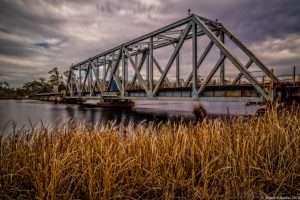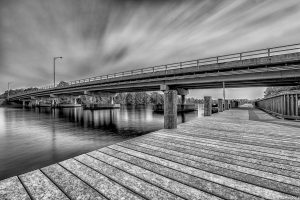Tiny towns are not for everyone. Stu and I love them. Many times, they are a window into the lifestyles of yesteryear both architecturally and culturally. They just FEEL different! The vibe is laid-back and personal. Such towns have survived much longer than we, as visitors have and seem to boast a happy contentment that they will survive long after we are gone.
Milton, Florida is nothing special and yet, it is! Milton is “old-time” Florida and has blocks of historic homes and storefronts that lead to the Blackwater River waterfront. This is a sleepy town on the water where life is secure and peaceful. Milton can trace its history back to 1559 when Don Tristan de Luna first explored the panhandle of Florida!
Milton is locally called, “The Canoe Capital of Florida.” You see, Milton is surrounded by waterways like Coldwater and Sweetwater Creeks and the Blackwater River. In fact, downtown Milton is located along the banks of the Blackwater River and is listed on the National Register of Historic Places. The town is one of the oldest in Florida and was incorporated in 1844 under the Florida Territorial Acts of 1844 before Florida became a state. Pioneers began settling along the backs of the ricer in the early 1800s.
THE NAME OF “MILTON”
We enjoy learning about how towns get their names! According to local legend, Milton was called “Scotsman Anchorage” for the barges that ran up and down the Blackwater River carrying timber. The town was also called “Scratch Ankle” for the brambles and briars along the riverbank and “Hell-Town” in honor of the mosquitoes and snakes.
The Blackwater River served as the major transportation system for Milton’s largest industry, ship building. As the town grew during the industrial revolution, it was renamed, “Milltown.” Eventually, that name became Milton.
A LITTLE HISTORY

The industrial and commercial infrastructure in Milton was destroyed by the Union Army during the Civil War. Poverty became pervasive and many residents relocated to Alabama.
The railroad came to Milton in the 1880s and renewed the timber industry. Following the timber boom, the area was filled with cotton and peanut fields. Two separate fires destroyed Milton with one in 1885 and one in 1892. A third fire, in 1909, destroyed the remaining town.
Milton rebuilt after 1909 and many of the current town buildings date from the rebuilding. Bagdad is a small historic town to the south of downtown Milton and also boasts many historic buildings.
WHAT TO SEE IN MILTON, FLORIDA
Be sure to go see St. Mary’s Episcopal Church and Rectory on Oak Street. This church dates from 1888 and is a wonderful example of Carpenter Gothic architecture. The church is on the National Register of Historic Places. This church was even mentioned in architect Frank Lloyd Wright’s book, “THE AESTHETICS OF AMERICAN ARCHITECTURE.”
See the Imogene Theatre on Carolina Street. The Theatre has walls four bricks thick and is the only three-story building in town. Opened in 1913, the Imogene was the first building to have central air conditioning. The Theatre now houses the Santa Rosa County Historical Society and Museum of Local History.
Go visit:
- The Santa Rosa County Courthouse, opened in 1927 on Caroline Street.
- Mount Pilgrim African American Missionary Baptist Church on Dr. Martin Luther King, Jr. Drive (Now part of the Florida Black Heritage Trail)
- The Milligan-Whitmire House on Berryhill Street, built in 1889 by confederate Captain Rufus. Milligan. Today it is often called “The Gingerbread House.”
- The W.J. Williams House next door to the Milligan House built in 1887. It has the nickname of the “Steamboat House.”
- L&N Depot, built in 1909, which houses the West Florida Railroad Museum.
NAVAL AIR STATION WHITING FIELD
As WWII demanded America’s participation, Milton was the site chosen for NAS Whiting Field, the training installation for Naval Aviators. Commissioned in 1943, Whiting’s complement grew to 3,300 officers and men and 1,431 students.They used SNBs, SNJs and PBYs to train the students. WAVES operated Link Trainers to simulate flight conditions while students remained on the ground.
German POWs from the Army facility at Camp Rucker, Alabama were transferred to Whiting for construction and soil erosion projects. The number of detainees reached as high as 225, until they were released in 1946. Today, Whiting Field is the busiest Naval Air Station in the world and is responsible for 46% of the Chief of Naval Air Training Command’s total flight time and more than 11% of Navy and Marine Corps total flight time.*

So, if you enjoy small towns, put Milton on your list!